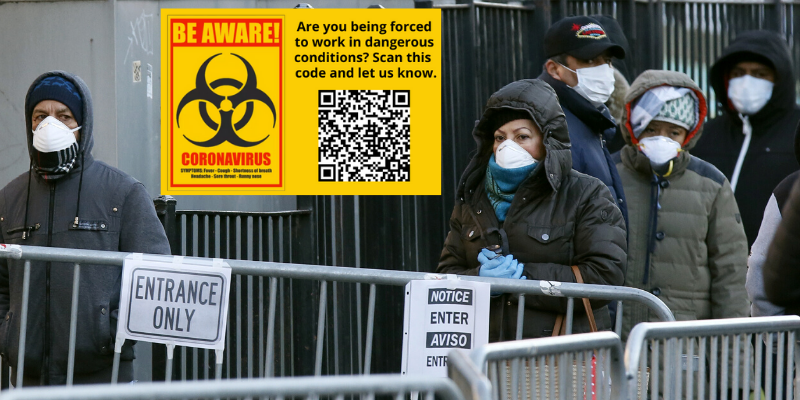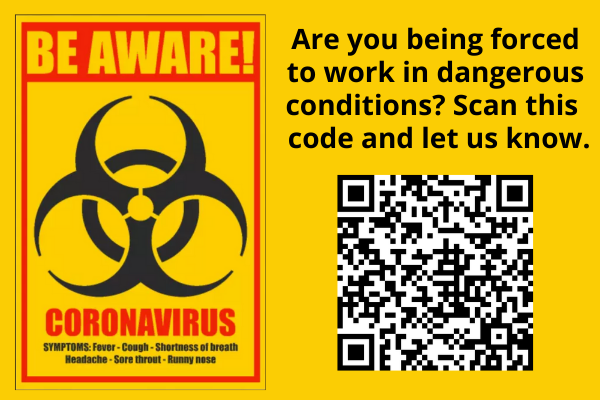

Workers pressured back to work in dangerous conditions have a tough choice: their paycheck or their lives? How can they organize for safe working conditions and fair wages in such a harsh environment?
Background
Corporations and weak regulators are in the headlines as COVID-19 spreads at plants. Workers struggle to have their grievances heard while corporations conceal the number of COVID-19 infections and deaths at their plants.
– “The Labor Department is forcing workers back to jobs that could make them sick” – WaPo
– “Workers Are Forced To Choose Between Health And Wages” – WAMU
– “Regulators sat on COVID-19 complaints at Iowa meat plant” – Des Moines Register
Need
Organizers struggle to collect details from workers who’d rather keep a low profile and pressed for time. How can this be done quickly and discreetly? Grassroots innovators have developed a cost-effective way to organize workers with the same technologies that corporations use.
Solution
Flyers with a QR codes are posted where workers can easily see them and distributed online. Workers scan the code with their phones and hit send. The whole process takes a three seconds. This action sends a text to a chatbot that collects their details and saves it in a database.

How it works Effective messages are clear and get their point across in seconds. Campaigns need a way to make it easy for workers to respond but still share the information needed for effective follow-up. They create digital flyers with simple graphics, a clear call to action and a QR code. The flyers were shared by online and printed on signs were placed near plants and hospitals.
Workers entering the plant scan the QR code with their phone and hit Send. This sends a text to the campaign’s hotline along with the worker’s details. The texts are handled by a chatbot which can optionally ask questions. The worker’s contact details and answers are automatically saved. A chatbot can handle hundreds of texts at the same time.
Point your camera at the QR codes on campaign these images to see how easy it is.

Black Voters Matter increases political power in Black communities and have a petition underway. “We are people who believe that we should not have to choose between the safety of our people and the economic wellness of our state. We are people who believe that there are solutions that do not require us to choose between the safety of our families and having enough money to put food on the table.”

Power Coalition For Equity & Justice works to build voice and power in traditionally ignored communities of color. The coalition works across Louisiana to organize in impacted communities, educate and turn out voters. It has a COVID-19 safety campaign. “The coronavirus outbreak is an unprecedented challenge that we must all take very seriously. Stay home if you can. If you MUST go out, practice social distancing and stay at least six feet away from other people.”
Details
Chatbots are widely used by corporations to respond to serve customers. Uber and Lyft, for instance use texting platforms like Twilio to alert passengers when their driver is arriving. Chatbots have traditionally been used mainly by large firms due to their high costs and the complexity.
The cost of a customized chatbot starts at $300 and they can usually be created in two days. Four things are needed to create a chatbot:
1. The preferred area code for the chatbot’s phone number
2. The greeting that the chatbot start with
3. The questions the chatbot should ask
4. The good bye message the chatbot should use
The chatbot saves the respondent’s phone number and answers to a database. Organizers follow-up with workers using the opt-in information they have provided. Chatbots can be repurposed for different campaigns by just changing the questions they ask and the details they give workers.
Affordable
It costs less than one cent to send or receive a text with Twilio. Asking a worker five questions and getting five answers by text messages costs 10 cents. The cost of setting up a bot to handle inquiries from workers outside a meat packing plant (say) and having 200 workers respond to a five question survey would cost:
$300 to create the chatbot + (10 cents/response x 200 workers) = $320
Cost per worker record collected for 200 workers = $1.60 ($320/200 workers)
The cost per record for 1,000 responses would be
$300 to create the chatbot + (10 cents x 1000 workers) = $400
Cost per worker record collected for 1,000 workers = $0.40 ($400/1000 workers)
Take away
Technology is a double-edged sword. What works for corporations, also works to organize their exploited workers.
Deepak
Co-Founder, DemLabs











